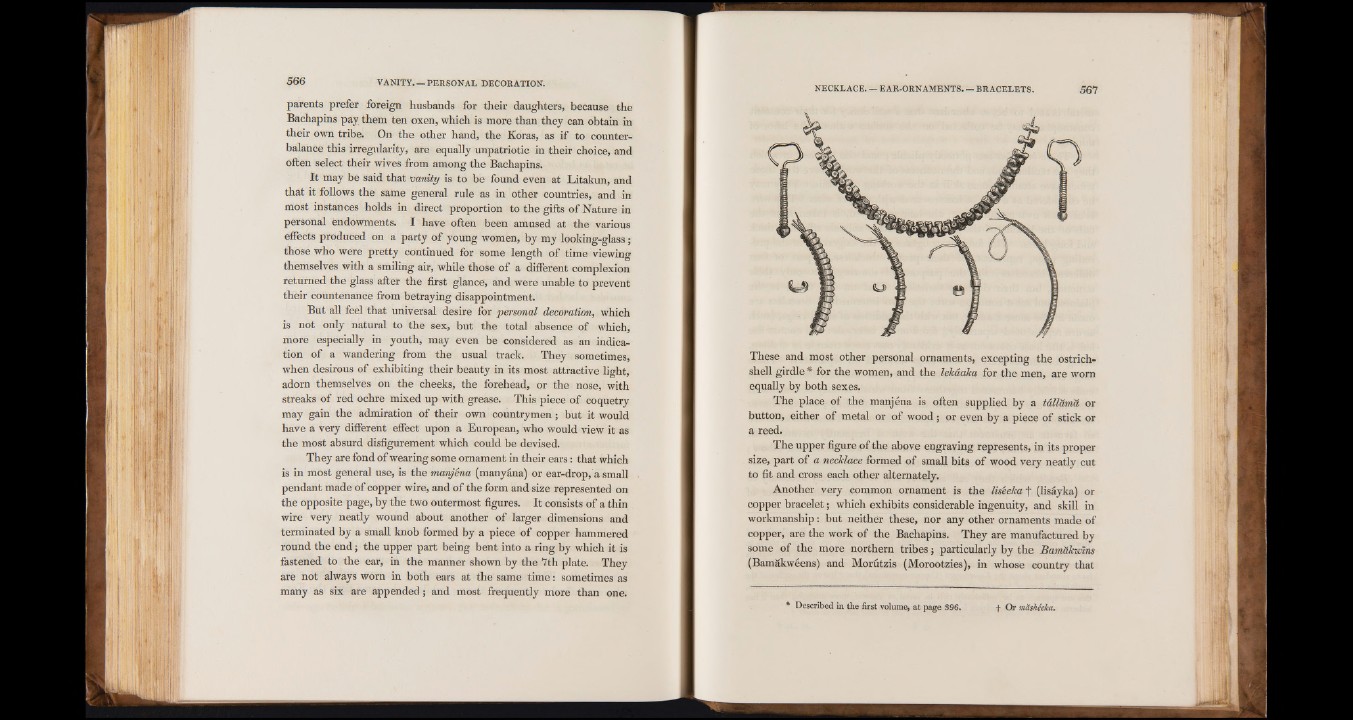
parents prefer foreign husbands for their daughters, because the
Bachapins pay them ten oxen, which is more than they can obtain in
their own tribe. On the other hand, the Koras, as if to counterbalance
this irregularity, are equally unpatriotic in their choice, and
often select their wives from among the Bachapins.
It may be said that vanity is to be found even at Litakun, and
that it follows the same general rule as in other countries, and in
most instances holds in direct proportion to the gifts of Nature in
personal endowments. I have often been amused at the various
effects produced on a party of young women, by my looking-glass;
those who were pretty continued for some length of time viewing
themselves with a smiling air, while those of a different complexion
returned the glass after the first glance, and were unable to prevent
their countenance from betraying disappointment.
But all feel that universal desire for personal decoration, which
is not only natural to the sex, but the total absence of which,
more especially in youth, may even be considered as an indication
of a wandering from the usual track. They sometimes,
when desirous of exhibiting their beauty in its most attractive light,
adorn themselves on the cheeks, the forehead, or the nose, with
streaks of red ochre mixed up with grease. This piece of coquetry
may gain the admiration of their own countrymen; but it would
have a very different effect upon a European, who would view it as
the most absurd disfigurement which could be devised.
They are fond of wearing some ornament in their ears: that which
is in most general use, is the manjena (manyana) or ear-drop, a small
pendant made of copper wire, and of the form and size represented on
the opposite page, by the two outermost figures. It consists of a thin
wire very neatly wound about another of larger dimensions and
terminated by a small knob formed by a piece of copper hammered
round the end; the upper part being bent into a ring by which it is
fastened to the ear, in the manner shown by the 7th plate. They
are not always worn in both ears at the same tim e: sometimes as
many as six are appended; and most frequently more than one.
NECKLACE. — EAR-ORNAMENTS. — BRACELETS. 567
These and most other personal ornaments, excepting the ostrich-
shell girdle * for the women, and the lekaaka for the men, are worn
equally by both sexes.
The place of the manjena is often supplied by a talttmii or
button, either of metal or of wood; or even by a piece of stick or
a reed.
The upper figure of the above engraving represents, in its proper
size, part of a necklace formed of small bits of wood very neatly cut
to fit and cross each other alternately.
Another very common ornament is the liseeka f (lisayka) or
copper bracelet; which exhibits considerable ingenuity, and skill in
workmanship: but neither these, nor any other ornaments made of
copper, are the work of the Bachapins. They are manufactured by
some of the more northern tribes; particularly by the Bamtikwins
(BamSkweens) and Morutzis (Morootzies), in whose country that